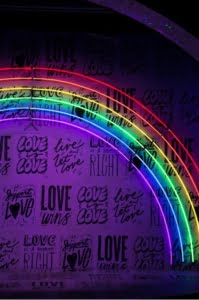 June marks LGBTQ+ pride month. This month is celebrated every year in June to honor the Stonewall Uprising in Manhattan in 1969. Celebrations of pride month include parades, parties, workshops, and memorials at local, national, and international levels. The purpose of this month is recognize the impact that lesbian, gay, bisexual, and transgender individuals have had on history. This month, to celebrate the LGBTQ+ community, let’s take a look at what it means to be gender inclusive and what that can look like – a safe, welcoming space for everyone. Its important to note that supporting the LGBTQ+ community helps everyone, not just LGBTQ+ folks!
June marks LGBTQ+ pride month. This month is celebrated every year in June to honor the Stonewall Uprising in Manhattan in 1969. Celebrations of pride month include parades, parties, workshops, and memorials at local, national, and international levels. The purpose of this month is recognize the impact that lesbian, gay, bisexual, and transgender individuals have had on history. This month, to celebrate the LGBTQ+ community, let’s take a look at what it means to be gender inclusive and what that can look like – a safe, welcoming space for everyone. Its important to note that supporting the LGBTQ+ community helps everyone, not just LGBTQ+ folks!
By definition, inclusivity is “the practice or policy of providing equal access to opportunities and resources for people who might otherwise be excluded or marginalized” (Oxford Dictionary). In other words, it means to be open to everyone and not limited to certain people. In terms of gender, this means that services, establishments, schools, practitioners, government agencies, and other institutions are welcoming of all people regardless of their gender identity or expression. Gender inclusivity is important to keep in mind not only in the workplace, but in everyday life when interacting with others.
Why should I care about gender inclusivity?
Before we get into how to be gender inclusive, let’s talk about what gender is and get an understanding of what gender identity means. Gender is a distinct identity from biological sex. Typically biological sex is assigned at birth and marked by genitalia and internal sex characteristics. We typically assume a person’s gender based on their sex assigned at birth. However, personal gender identity can differ from biological sex. The assumption of someone’s gender based on their sex is a social construct that has been taught to us. Everyone has their own assumptions about the roles, rights, and responsibilities of men, women, boys, and girls. This is what makes up the gender binary which is the idea that only the two genders of male and female exist. Gender identity refers to how someone feels about their gender in their hearts, body, and soul. All individuals have a personal and sujective inner sense of self as belonging to a particular gender. Gender exists on a spectrum or continuum and is fluid. Gender expression is typically categorized as masculine or feminine, but it’s important to remember that it can be both or androgynous. The key takeway to this, is that we should not be defining people based on their bodies, but rather as how they define themselves and how they feel the most authentic.
In a society that views gender as a binary rather than a spectrum, people who don’t subscribe to the traditional definitions of masculinity or feminity are often rendered invisible. They often experience discrimination, bullying, verbal and physical violence, and exclusion. Many people who are non-binary, genderqueer, or intersex often feel pressured to hide their identity to avoid unwanted attention, questions, or ostracism. This signifies that we all have the responsibility of being mindful of the ways we may have internalized expectations, stereotypes, or implicit biases that impact the way we interact with others. Showing support and cultivating a safe space for everyone is an important factor in creating an inclusive environment.
Now that we know a little more about what gender is, let’s take a look into how we can be more gender inclusive.
- Language
- Gender inclusive language is something we all can do!
- Some examples of gender inclusive language includes using “folks/everybody” instead of “you guys” or “ladies and gentlemen”
- Pronouns
- Sharing your pronouns as well as asking others what their pronouns are can demonstrate gender inclusivity
- Using the correct pronouns and correct yourself if you use the wrong one.
- Stick to gender neutral pronouns like they/them when referring to someone who’s pronouns you don’t know.
- Try not to make assumptions
- Get to know someone in order to use accurate pronouns rather than assuming based on how they look.
- Ask!
- When in doubt, its okay to ask someone’s pronouns and share your own. It indicates that you are supportive, inclusive, and respectful of gender, pronouns, and gender identity.
Capital Region Pride Events for the month of June
For more information and description of all events: https://www.518capitalpride.com/2022-events-1
- June 1: Albany Pride Flag Raising
- Weds, 10am-11:am
- Albany, NY
- Pride Kick-off Block Party
- Weds, 4-8pm
- Waterworks Pub
- Albany NY
- June 12th: 2022 Capital Pride Festival
- Sun, 12-5pm
- Washington Park
- Albany NY
- June 25: Capital District Reclaim Pride 2022
- Sat, 4pm
- Townsend Park, Central Ave and Henry Johnson Blvd
- Albany NY
- June 17: Albany LGBTQA Youth Group (Ages 13-17)
- Fri, 3:00-8:30pm
- Pride Center of the Capital Region
- 332 Hudson Ave, Albany NY 12210
- June 11: Say it Loud! Black and Latino Gay Pride
- Sat, 12-5pm
- Washington Park
- Albany NY
- June 25: Pride 5K Rainbow Run
- Sat, 9-11am
- Jennings Landing
- Albany NY
- June 8: Teen Pride Flag Kit
- Weds
- Clifton Park Halfmoon Public Library
By, Amanda Navarra, MHC intern
